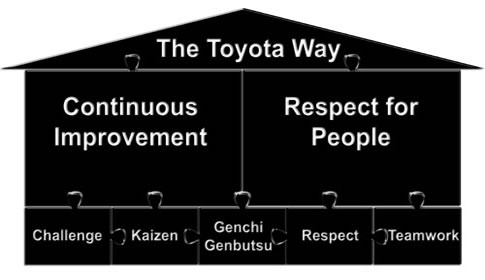Challenging 'Challenge' Within the Toyota Way
At the heart of the Toyota Way are two pillars, continuous improvement and respect for people. These are supported by five values: challenge, improvement (kaizen), seeing for yourself (genchi genbutsu), respect, and teamwork. The word "challenge" means either a tangible thing, such as competition or obstacles to overcome, or the action to engage in a contest, adventure, or experiment that may succeed or fail.
It seems clear enough that kaizen, genchi genbutsu, respect, and teamwork are intended as principles to turn into action, but the meaning and intent of challenge is more ambiguous. Here is an image of the Toyota Way pillars and foundation from Toyota's website.
When we are faced with challenges, too many times it is not by choice. Neither is it clear whether these conditions are actual challenges (as in surmountable obstacles) rather than muri (unreasonable burden of work). We do not want to pursue great dangers when we should merely be striving to improve ourselves. If we are to learn from and put the Toyota Way into practice, it would seem that making this distinction is critical.
There seems to be some confusion even among how "challenge" is described at Toyota. It is described thus on the Toyota website as the people foundation or inspirational way of working:
"Toyota believes that an effective workplace is one that allows people of different ages, genders, ethnic groups, and cultural backgrounds to work together as a team. We believe in challenges and the importance of decisions based on personal investigation, efficient fact-finding, and in-depth analysis. Working at Toyota is also an exercise in long-term thinking."
We believe in challenges. What does this mean? We cannot believe in challenges in the same way that we believe in ghosts or don't believe in ghosts. Challenges are unquestionably real, however subjective. Does it mean, "We believe in facing challenges rather than running away" or "We believe in giving ourselves challenges where none exist"? The latter seems most likely, based on the "no problem is a problem" mentality at Toyota and the notion of constant dissatisfaction with the status quo.
On the Toyota Europe website there is a one-by-one definition of the building blocks:
"Challenge: This means not only embracing challenges, but also challenging what we know and do, and being prepared to change things to make improvements."
This is a bit more helpful and addresses the change element of continuous improvement through questioning the current standards, paradigms, knowledge, best practices, and so forth. This is the active form of challenging. However, "embracing challenges" means being responsive or reactive to crises that come our way, whether we welcome them or not.
In yet another common explanation of the Toyota Way, challenge is explained in a different context that is both proactive (vision-setting) and reactive (meeting emergent challenges):
"We form a long-term vision, meeting challenges with courage and creativity to realize our dreams."
Although this is thematically consistent with challenge as an aspirational thing, or striving to realize one's dreams, the wording emphasizes responding to challenges rather than challenging our own internal conditions. Both forms of challenge are necessary but quite different things, requiring different behaviors, leadership, and tactics.
Enviado desde mi iPad
Comentarios